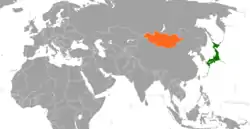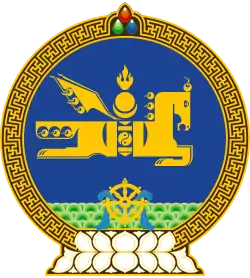Japan–Mongolia relations
Relations between Mongolia and Japan (Mongolian: Монгол, Японы харилцаа, Japanese: 日本とモンゴルの関係 / 日蒙関係) began in the 13th century, but the two countries had no formal, diplomatic interactions until the late 20th century.
 | |
Japan |
Mongolia |
|---|---|
History
Mongol invasions

By 1259, Korean resistance to the Mongol invasion had collapsed.[1] With Korea under Mongol control,[2] the attempts by the Mongol Empire to invade the Japanese Archipelago began after the Goryeo Dynasty (now Korea) formed an alliance with Kublai Khan of the Mongols.[3]
Kublai sent several emissaries, in 1268, demanding that the "king" of Japan submit to the Empire, under its mandate from Eternal Heaven. These emissaries were either ignored or rebuffed by Japan, and as a consequence in October 1274 Kublai sent an invasion fleet across Tsushima Strait to Tsushima Island, comprising over 900 ships and 20,000 soldiers. This, the first invasion, overran Tsushima and Iki. From there they sailed to Hakata Bay, which resulted in the Battle of Bun'ei, where what the Japanese were later to call a kamikaze ("divine wind") wrecked the invading forces in their ships.[3]
The second attempted invasion came after more envoys had been sent in 1275 and 1279. At that time, the Japanese beheaded them rather than simply refusing them. As a consequence, Kublai dispatched another invasion fleet, consisting the Song fleet, which the Empire captured in 1275, and a further 1,000 ships supplied by Goryeo. The latter arrived in Japan in May 1281 before the Song fleet, and attacked Hakata without waiting for the Song ships, and also without success. Thus began the Battle of Kōan. The Song fleet arrived later, and also attacked Hakata, but were unable to overcome Japanese forces. Eventually, on the 15th of August, another kamikaze wrecked the invading forces in their ships.[4]
Before World War II
After the collapse of the Qing Dynasty that had ruled Mongolia for some centuries and the Outer Mongolian revolution of 1911 (for more of the history, see History of Mongolia.) and after the rise of Japan to world power status in the early 20th century, the Mongolian government of Bogd Khan sent emissaries requesting formal diplomatic recognition to various world powers, including the Internal Affairs Minister, Da Lam Tserenchimed, who was sent to Japan in 1913. [4]
Since World War II
After World War II, diplomatic relations between Japan and Mongolia did not resume until 1972. They remained uncooperative until the 1990 Democratic Revolution in Mongolia, whereupon Sousuke Uno's visit in April 1989 and Toshiki Kaifu's visit to Mongolia in August 1991, following the visit by Dumaagiin Sodnom to Japan in March 1990, became the first visits to Mongolia by a non-Eastern Bloc minister and prime minister, respectively.[5]
More recently Japan and Mongolia have been seeking relationship improvements.[6] In 2008, the Japan Bank for International Cooperation financed a ¥28.8 billion (US$385 million ) loan for the government of Mongolia to build a new international airport in Töv Province to service Ulan Bator (currently serviced by Buyant-Ukhaa International Airport). Construction lasted between 2012 and 2017.[7] The new airport is 60 kilometres (37 mi) from the capital and is designed to handle 1.65 million passengers annually.[8]
References
Cross-reference
- Henthorn, William E. (1963). Korea: the Mongol invasions. E.J. Brill. p.150-162
- Michael Burgan, Empire of the Mongols, with Christopher Atwood, Chelsea House, ç2009, p.43
- Sanders 2010, p. 356.
- Sanders 2010, p. 357.
- Sanders 2010, p. 358–359.
- Japan Seeks Stronger Mongolia Ties March 30, 2013 Wall Street Journal
- admin. "ХӨШИГИЙН ХӨНДИЙН НИСЭХ ОНГОЦНЫ БУУДАЛД УЛСЫН КОМИСС АЖИЛЛАЖ ЭХЭЛЛЭЭ". NUBIA | New Ulaanbaatar International Airport Project. Retrieved 2017-01-03.
- China Daily 2012
Reference bibliography
- Sanders, Alan J. K. (2010). "Japan: Relations with Mongolia". Historical Dictionary of Mongolia. Historical Dictionaries of Asia, Oceania, and the Middle East. 74 (3rd ed.). Scarecrow Press. ISBN 9780810861916.
- "Mongolia starts to build new int'l airport". China Daily. Retrieved 26 August 2012.

